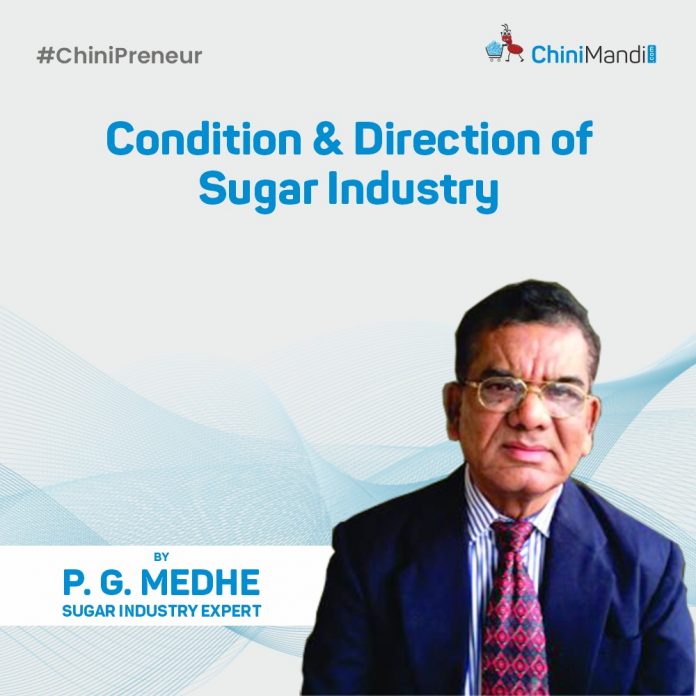Nowadays it is seen that sugarcane price dues are increasing day by day. It is becoming very difficult to make the cane payment within 14 days to the cane suppliers for their cane supplied to the sugar factories. There are number of reasons behind this mismatch. Sugar has been enlisted in the category of “ Essential Commodity “ and hence attracting the provisions of “ Essential Commodities Act” and corresponding Sugar Control Orders.
Legal Provision:-
The statutory provisions of Sugarcane (Control) Order, 1966 issued under the Essential Commodities Act (ECA), 1955, govern the pricing of sugarcane in India. On 22nd October 2009, the Sugarcane (Control) Order, 1966 was amended and the concept of Statutory Minimum Price (SMP) of sugarcane was replaced with the ‘Fair and Remunerative Price (FRP)’ from 2009-10 sugar season. In order to incentivise higher sugar recoveries, the FRP is linked to a basic recovery rate of sugar, with a premium payable to farmers for higher recovery of sugar from sugarcane. The Central government had delegated powers to the State Governments vide Gazette Notification G.S.R. 663(E), dated 22ndOctober, 2020, for fixation of mill-wise FRP for every sugar season from 2019-20 onwards.
Fixation of FRP for sugarcane:-
The Fair and Remunerative Price (FRP) for sugarcane is typically fixed by the Govt. Of India in consultation with various stakeholders, including sugarcane farmers, sugar mills, and industry representatives. The government considers factors such as input costs, market prices for sugar and other related commodities, inflation rates, and overall economic conditions when determining the FRP. The final decision is often influenced by recommendations from the Commission of Agricultural Cost and Prices (CACP).
The FRP fixed by the Govt. during the period from 2013 to 2023 is as follows:-
| वर्ष | एफआरपी | बेस रिकवरी (प्रति क्विंटल) |
| 2013 | 210 | 9.50 % |
| 2014 | 220 | 9.50 % |
| 2015 | 230 | 9.50 % |
| 2016 | 230 | 9.50 % |
| 2017 | 255 | 9.50 % |
| 2018 | 275 | 10 % |
| 2019 | 275 | 10 % |
| 2020 | 285 | 10 % |
| 2021 | 290 | 10 % |
| 2022 | 305 | 10.25% |
| 2023 | 315 | 10.25% |
Minimum Selling Price of Sugar:-
The system of levy obligations on mills for sugar produced was discontinued by Government of India in October 2012 and the regulated release mechanism on open market sale of sugar was abolished to de-regulate sugar sector. However, in view of depressed sugar prices due to surplus production and to protect interest of farmers, Government introduced the concept of Minimum Selling Price (MSP) of sugar based on FRP of sugarcane and minimum conversion cost of the most efficient mills w.e.f 7th June 2018 under Sugar Price (Control) Order, 2018. The MSP of white/refined sugar was fixed at ₹29 per kg w.e.f 7thJune, 2018 for sale by sugar mills at the factory gate for domestic consumption, which was increased to ₹31 per kg from 14th February, 2019 but Inspite of five times revision in FRP, MSP of sugar has not been revised thereafter by Government despite strong demand from sugar industry. Price of sugar should ideally be determined by supply and demand forces of market. While fixing the MSP of sugar, it is recommended to consider the FRP, conversion cost, financial overhead and normative returns of the mills. Due to this mismatch, we find huge cane price dues all over the country.
Ethanol Blended Petrol (EBP) Programme:-
The Government of India notified the National Policy on Biofuels-2018 (NPB-2018) wherein, under the Ethanol Blended Petrol (EBP) Programme, an indicative target of 20% blending of ethanol in petrol by 2030 was laid out. However the target has now been advanced to ESY 2025-26. The EBP Programme is being promoted with the objectives of providing a boost to the domestic agriculture sector, perceived environmental benefits, reduction in import dependency and savings in foreign exchange. A NITI Aayog report titled, “Roadmap for Ethanol Blending in India 2020-25” has estimated an ethanol demand of 1,016 crore litres based on expected vehicle growth. The sugar industry, thus, could be a major player in ethanol supply. Diversion of sugarcane to ethanol production could be a win-win situation for both the farmers as well as for ensuring the energy security of the country. Of the total existing ethanol production capacity of 834.7 crore litre in India, two largest sugarcane producing States, Uttar Pradesh and Maharashtra account for 50 per cent capacity. Under the EBP, these States have achieved blending of about 22 per cent of the total ethanol supply of 113.2 crore litre in 2021-22
Switching over to caneprice method on the basis of “Pole in Cane” basis:-
Taking into considerations above facts and figures, it is need to switch over to the cane price fixing method on the basis of “Pole in Cane” basis.
What is Pol in Sugarcane?
In the context of sugarcane, “Pol” refers to the polarization or sucrose content present in the cane. It is typically expressed as a percentage and indicates the amount of sucrose present in the juice extracted from the sugarcane.
The Pol content is an important factor in determining the quality and potential sugar yield of the sugarcane. Higher Pol content means that there is a higher concentration of sucrose in the juice, which translates to higher sugar recovery during the processing of sugarcane into sugar.
Sugar mills often measure the Pol content of sugarcane before processing it to determine its quality and to estimate the potential sugar yield. This helps in optimizing the sugar extraction process and ensuring efficient sugar production.
Is it possible to fix sugarcane price on the basis of pol in cane?
Yes, it is possible to determine sugarcane prices based on the Pol content in the cane. This method is known as Pol-based pricing or sugar recovery-based pricing. Here’s an overview of the method typically adopted:
1) Pol Testing:
Sugarcane is sampled and tested for its Pol content before processing in the sugar mill. This is usually done using a polarimeter or refractometer to measure the sucrose content in the cane juice.
2) Price Calculation:
The price paid to sugarcane farmers is then calculated based on the Pol content of the cane. Higher Pol content indicates higher sugar content and therefore higher sugar yield during processing. Consequently, farmers are typically paid a higher price per ton of sugarcane if the Pol content is higher.
3) Pricing Formula:
Sugar mills often use a pricing formula that takes into account the Pol content along with other factors such as transportation costs, harvesting expenses, and government regulations.
4) Negotiation and Agreement:
The pricing system based on Pol content often involves negotiations between sugarcane farmers and sugar mills or government authorities. Once an agreement is reached on the pricing formula and other terms, it is implemented for the duration of the harvesting season.
5)Monitoring and Review:
Throughout the harvesting season, the Pol content of sugarcane may vary due to factors like weather conditions, soil quality, and crop management practices. Therefore, the pricing system may include provisions for monitoring and reviewing the Pol content periodically to ensure fairness and accuracy in pricing.
By adopting a Pol-based pricing mechanism, sugarcane farmers can be incentivized to cultivate varieties with higher sugar content and implement better agricultural practices to maximize sugar yield, ultimately benefiting both farmers and sugar mills.
Few convenient method to measure pol content in cane:-
The most common and convenient method to measure the Pol content in sugarcane is by using a refractometer. A refractometer is a simple and portable device that measures the refractive index of a solution, which is directly related to the sugar content.
Typically working of the process:-
1) Sample Preparation:
Extract juice from a representative sample of sugarcane stalks. This can be done by cutting the sugarcane into small pieces and then crushing or pressing them to extract the juice.
2) Calibration:
Calibrate the refractometer according to the manufacturer’s instructions. This usually involves adjusting the instrument to zero using distilled water or a calibration solution.
3) Testing:
Place a few drops of the sugarcane juice onto the prism or test plate of the refractometer. Close the cover to ensure that no air bubbles are present.
4) Reading:
Look through the eyepiece of the refractometer and focus until the boundary line between the light and dark areas is sharp and clear. The scale on the refractometer will display the refractive index or Brix value, which is directly related to the sugar content.
5) Conversion:
Convert the Brix value to Pol percentage using a conversion chart or formula. The conversion factor may vary depending on factors such as temperature and variety of sugarcane.
It’s important to note that while refractometers provide a quick and convenient way to estimate the Pol content in sugarcane, they may not provide highly accurate results compared to laboratory methods such as polarimetry. However, for routine field measurements and quality control purposes, refractometers are widely used and effective.
System followed in foreign countries like Brazil in measuring pole in cane :-
In countries like Brazil, where sugarcane cultivation is a significant industry, the Brix scale is commonly used to measure the sugar content in sugarcane. Brix is a measurement scale that indicates the percentage of total soluble solids in a solution, which includes not only sucrose but also other soluble components like glucose, fructose, and organic acids.
The Brix scale is measured using a refractometer, similar to the process described earlier. However, in the case of sugarcane, the Brix value obtained from the refractometer is often used as an indirect measure of the sugar content, rather than directly converting it to Pol percentage.
In Brazil, sugar mills typically pay sugarcane farmers based on the Brix value of the cane delivered to the mill. The specific pricing formula may vary depending on factors such as the efficiency of the mill, transportation costs, and government regulations. However, the Brix value serves as a key indicator of the sugar content and quality of the sugarcane, influencing the price paid to farmers.
Overall, while the method of measuring sugar content may vary slightly between countries, the use of refractometers and Brix values is common in many sugar-producing regions worldwide.
Difference between average recovery base FRP fixed by the CACP assuming base recovery and Cane price payments on the basis of pole in cane of sugarcane supplied by the individual farmers:-
1) Average Recovery Based FRP with Incremental Rate for Increase in Sugar Recovery:
In this system, the FRP is fixed by the Commission for Agricultural Costs and Prices (CACP) assuming a base recovery rate of, for example, 10.25%. The FRP is set considering this base recovery rate, and then an additional rate is added for each percentage increase in sugar recovery above the base rate. This means that farmers are compensated based on an average recovery rate, and those who achieve higher recovery rates receive additional payments.
2) Cane Price Payments as per Actual Sugar Recovery:
In this system, farmers are paid based on the actual sugar recovery of the sugarcane they supply to the mill. The sugar content is measured using methods like Pol testing, and farmers are compensated accordingly. This means that farmers are directly rewarded for the quality and sugar content of their sugarcane, with higher payments for higher sugar content.
Which can be convenient method for fixing sugarcane price to avoid complications and will remain as motivational to produce good quality cane :-
Here’s a suggested approach:
1) Base FRP with Incremental Rate for Increase in Sugar Recovery:
Set a base Fair and Remunerative Price (FRP) for sugarcane based on average recovery rates. This provides a guaranteed minimum price to sugarcane farmers, ensuring stability and predictability in income.
2) Additional Payments for Higher Sugar Recovery:-
Offer incremental payments for sugarcane deliveries that exceed the base recovery rate. For every percentage increase in sugar recovery above the base rate, provide an additional incentive payment to the farmers.
This incentivizes farmers to focus on improving the quality and sugar content of their sugarcane.
3) Transparency and Fairness:
Ensure transparency in the pricing mechanism and fairness in the measurement of sugar content. Implement clear guidelines and procedures for sugar content measurement, and involve stakeholders such as farmers’ associations and sugar mills in the pricing decisions.
4) Educational and Extension Services:
Provide farmers with access to educational resources, training, and extension services to help them improve cultivation practices and maximize sugar recovery. Empowering farmers with knowledge and resources can enhance their ability to produce high-quality sugarcane.
5) Regular Review and Adjustment:
Periodically review and adjust the pricing mechanism based on market conditions, technological advancements, and feedback from stakeholders. This allows for flexibility and adaptation to changing circumstances while ensuring that the pricing system remains fair and effective.
By adopting a hybrid approach that combines elements of both fixed FRP and incentivized payments for higher sugar recovery, it is possible to create a pricing mechanism that is relatively simple to administer while also motivating farmers to produce good quality sugarcane.
Benefits of sugarcane price policy on the basis of pole in cane
The benefits of this system can concluded as follows:-
1) It will definitely motivate the cane cultivators for cane development activities so as to achieve more tonnes with higher sugar recovery per hectare…… increase in soil productivity.
2) Cane availability will increased
3) Increase in total sugar production
4) Cost of production of the cane will come down
5) Reduction in controversies between farmers and sugar factories in respect of cane price
5) More sugar will be available for ethanol production
6) Result in Ethanol Blending Program
7) Reduction in reliance on imported crude oil
8) Saving of foreign exchange of the country
9) Annual Income of the cane cultivators will be increased
Conclusion:-
Taking into considerations benefits of the system in question , it is high time to switchover to the sugarcane price policy on the basis of “POLE IN CANE” But it is to be noted that the successful implementation of a sugarcane price policy based on pol in cane requires coordinated efforts from various stakeholders including sugar factories, farmers, cane harvesting and transport contractors, as well as supportive government policies. Cooperation among these stakeholders is essential to ensure that the policy is effectively executed and benefits all parties involved. This may include establishing transparent pricing mechanisms, providing support and incentives for farmers to improve cane quality and productivity, and ensuring efficient transportation and logistics infrastructure. Additionally, government policies can play a crucial role in providing regulatory support, financial incentives, and market stability to facilitate the success of the policy.











